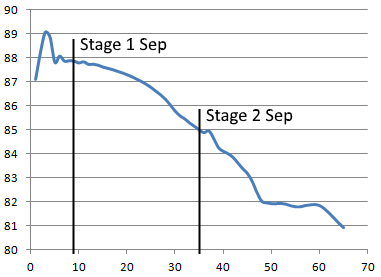 With three recovered launches so far, the Mk5 was on track to becoming the most successful new rocket design on record until yesterday’s fourth launch, which unfortunately broke apart during the third stage boost 64 seconds after lift off. Progenitor engineers have been pouring over all various data collected, including telemetry data received from the rocket prior to its breakup as well as launch videos, to try to determine what went wrong, under pressure due to the fact that of they can’t figure it out we would be forced to delay the fifth launch set to take place tomorrow, on the anniversary of our first rocket launch. While they are still not 100% sure as to what happened, with the data available they have come to the best conclusion possible, which thankfully will not result in a postponement of tomorrow’s launch as the circumstances that led to this recent failure should be avoidable for future launches.
With three recovered launches so far, the Mk5 was on track to becoming the most successful new rocket design on record until yesterday’s fourth launch, which unfortunately broke apart during the third stage boost 64 seconds after lift off. Progenitor engineers have been pouring over all various data collected, including telemetry data received from the rocket prior to its breakup as well as launch videos, to try to determine what went wrong, under pressure due to the fact that of they can’t figure it out we would be forced to delay the fifth launch set to take place tomorrow, on the anniversary of our first rocket launch. While they are still not 100% sure as to what happened, with the data available they have come to the best conclusion possible, which thankfully will not result in a postponement of tomorrow’s launch as the circumstances that led to this recent failure should be avoidable for future launches.
The conclusion reached is that upper-level wind shear literally tore the rocket apart, exacerbated by its high rate of speed at the time. Normally, the rocket would not be traveling as fast as it was but an error in the flight control software led to the third stage throttle being set to full thrust immediately after ignition rather than after dynamic pressure had begun to fall as the rocket climbed higher into the atmosphere. Engineers calculated that the wind shear alone could probably have still destroyed the rocket, but the excessive velocity made it all but impossible to survive.
Wind shear is a well-known atmospheric effect but it has never been thoroughly studied and its effects on rocket flight are completely unknown. In retrospect, Progenitor engineers admit we probably should have put more time and effort into researching wind shear and have begun talking with Lead Scientist Cheranne on possible future projects regarding this. In the meantime we will begin to collect data via a high-altitude KerBalloon that will now be released before every rocket flight to determine conditions in the upper atmosphere before launch. Flight Director Lanalye is already working with the KerBalloon program team to work the release into the launch countdown for tomorrow. For now, any detected wind shear will not violate a launch, again because we have no data to tell us whether the shear would be dangerous for the rocket. Unfortunately the best way to find out is to launch and see what happens. As more data is collected over time we will begin to better understand and predict the effects of wind shear for rockets we fly and can call off a launch under certain conditions.
As to the other attributing factor of the third stage engine throttling up to full thrust moments after ignition, engineers suspect that the code checking for whether or not the dynamic pressure is increasing runs too quickly after ignition for the thrust of the rocket to begin to counter-act the deceleration from the coast period. We will now have the code wait one second to allow the rocket to begin to pick up speed again before beginning to check for decreasing dynamic pressure. Although this launch reached the highest Mk5 apokee yet, engineers figure with the proper extended burn time we can possibly surpass the Mk4 record of 135km.
 Seen above is a graph of the rockets pitch over time (in seconds) and is one of the things that went very right on this launch. The 1-second delay in decoupling both boosters, which kept pitch oscillation to a minimum and allowed the third stage to coast 8 seconds before firing, is similar to how controllers manually triggered the engine during the first launch.
Seen above is a graph of the rockets pitch over time (in seconds) and is one of the things that went very right on this launch. The 1-second delay in decoupling both boosters, which kept pitch oscillation to a minimum and allowed the third stage to coast 8 seconds before firing, is similar to how controllers manually triggered the engine during the first launch.
Due to the short amount of time before the final launch tomorrow, there will be no major changes done to the AFCS other than to the operations code in order to fix the issue with the third stage throttle-up. Pre-launch operations are scheduled to start at 13:56 UTC.







